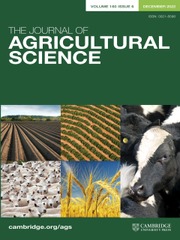Crossref Citations
This article has been cited by the following publications. This list is generated based on data provided by
Crossref.
N[otilde]mmik, Hans
1966.
The Residual Effects of Nitrogen Fertilizers in Relation to the Quantities of Mineral Nitrogen Recovered in the Soil Profile.
Acta Agriculturae Scandinavica,
Vol. 16,
Issue. 3-4,
p.
163.
Widdowson, F. V.
Penny, A.
and
Williams, R. J. B.
1967.
Experiments comparing the effects on yields of potatoes of three methods of applying three amounts of NPK fertilizer and the residual effects on following winter wheat.
The Journal of Agricultural Science,
Vol. 69,
Issue. 2,
p.
247.
Birch, J. A.
Devine, J. R.
Holmes, M. R. J.
and
Whitear, J. D.
1967.
Field experiments on the fertilizer requirements of maincrop potatoes.
The Journal of Agricultural Science,
Vol. 69,
Issue. 1,
p.
13.
Gasser, J. K. R.
and
Hamlyn, F. G.
1968.
The effects on winter wheat of ammonium sulphate, with and without a nitrification inhibitor, and of calcium nitrate.
The Journal of Agricultural Science,
Vol. 71,
Issue. 2,
p.
243.
WILLIAMS, T. D.
1969.
The effects of formalin, nabam, irrigation and nitrogen on Heterodera avenae Woll., Ophiobolus graminis Sacc. and the growth of spring wheat.
Annals of Applied Biology,
Vol. 64,
Issue. 2,
p.
325.
EBBELS, D. L.
1969.
Effects of soil fumigation on disease incidence, growth, and yield of spring wheat.
Annals of Applied Biology,
Vol. 63,
Issue. 1,
p.
81.
Draycott, A. P.
and
Last, P. J.
1970.
Effect of previous cropping and manuring on the nitrogen fertilizer needed by sugar beet.
The Journal of Agricultural Science,
Vol. 74,
Issue. 1,
p.
147.
Lyngstad, Ingvar
1975.
Residual Effects of Fertilizer Nitrogen in Soil.
Acta Agriculturae Scandinavica,
Vol. 25,
Issue. 4,
p.
330.
Burhan, H. O.
and
Said, M. B.
1975.
Residual effects of N, P and K applied to cotton on following crops of sorghum, dolichos and wheat in the Sudan Gezira.
The Journal of Agricultural Science,
Vol. 84,
Issue. 1,
p.
81.
Slope, D. B.
and
Etheridge, Judith
1977.
Effects of previous cropping and N fertilizer on grain yield and take-all in spring barley.
The Journal of Agricultural Science,
Vol. 89,
Issue. 2,
p.
459.
COOKE, G. W.
1979.
SOME PRIORITIES FOR BRITISH SOIL SCIENCE1.
Journal of Soil Science,
Vol. 30,
Issue. 2,
p.
187.
Iqbal, M. M.
Hussain, S. K.
and
Siddiqi, S. H.
1981.
Fertilizer residue from labelled urea in a clay soil.
Experientia,
Vol. 37,
Issue. 9,
p.
974.
Benzian, Blanche
and
Lane, Peter
1982.
Effects of husbandry treatments on nitrogen concentration of grain and related yields in winter‐wheat experiments made in South‐East England.
Journal of the Science of Food and Agriculture,
Vol. 33,
Issue. 11,
p.
1063.
Powlson, D. S.
Hart, P. B. S.
Pruden, G.
and
Jenkinson, D. S.
1986.
Recovery of 15N-labelled fertilizer applied in autumn to winter wheat at four sites in eastern England.
The Journal of Agricultural Science,
Vol. 107,
Issue. 3,
p.
611.
Sharma, R. C.
Govindakrishnan, P. M.
Singh, R. P.
and
Sharma, H. C.
1988.
Effects of farmyard manure and green manures on crop yields and nitrogen needs of potato-based cropping systems in Punjab.
The Journal of Agricultural Science,
Vol. 110,
Issue. 3,
p.
499.

